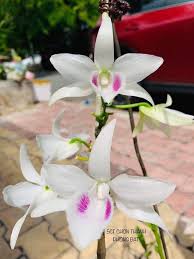# How to Create Organic Fertilizers from Natural Ingredients for Orchids

Orchids, particularly the beloved Phalaenopsis and Dendrobium varieties, are exquisite plants that require specific care and attention to thrive. One of the most crucial aspects of orchid care is fertilization. Organic fertilizers derived from natural ingredients not only nourish the plants but also enhance the health of the soil and the environment. In this comprehensive guide, we will explore various methods to create organic fertilizers from natural ingredients, tailored specifically for orchids.
## Table of Contents
1. **Understanding the Nutritional Needs of Orchids**
2. **Benefits of Organic Fertilizers**
3. **Common Natural Ingredients for Organic Fertilizers**
4. **Homemade Organic Fertilizer Recipes**
5. **Application Methods for Organic Fertilizers**
6. **Tips for Successful Fertilization**
7. **Conclusion**
—
## 1. Understanding the Nutritional Needs of Orchids
### 1.1 Essential Nutrients for Orchids
Orchids have specific nutritional needs that differ from other houseplants. They primarily require:
– **Nitrogen (N)**: Essential for vegetative growth and leaf production.
– **Phosphorus (P)**: Important for root development and flowering.
– **Potassium (K)**: Crucial for overall plant health, disease resistance, and flowering.
– **Calcium (Ca)**: Supports cell structure and growth.
– **Magnesium (Mg)**: Important for chlorophyll production and overall health.
– **Trace Elements**: Such as iron, manganese, and zinc, are necessary in small amounts for optimal growth.
### 1.2 Understanding Orchid Growth Phases
Orchids go through various growth phases: active growth, blooming, and dormancy. The nutritional needs of orchids vary during these phases, making it essential to adjust the fertilizer accordingly.
– **Active Growth Phase**: Orchids require higher nitrogen levels to support lush foliage.
– **Blooming Phase**: A shift to phosphorus-rich fertilizers encourages flower production.
– **Dormancy Phase**: Fertilization should be reduced, as orchids need less nourishment during this time.
—
## 2. Benefits of Organic Fertilizers
### 2.1 Environmental Impact
Organic fertilizers are derived from natural sources, making them eco-friendly alternatives to chemical fertilizers. They improve soil health, promote biodiversity, and reduce pollution.
### 2.2 Enhanced Soil Quality
Organic fertilizers enrich the soil with organic matter, improving its structure, water retention, and microbial activity. Healthy soil leads to better nutrient absorption for orchids.
### 2.3 Improved Plant Health
Using organic fertilizers can lead to stronger plants that are more resistant to pests and diseases. They promote balanced growth and help orchids adapt to their environment.
### 2.4 Safety for Users and the Environment
Organic fertilizers are safer for humans, pets, and beneficial organisms. They do not contain harmful chemicals that can leach into waterways or harm the ecosystem.
—
## 3. Common Natural Ingredients for Organic Fertilizers
### 3.1 Kitchen Scraps
– **Coffee Grounds**: Rich in nitrogen and beneficial microbes, coffee grounds improve soil acidity and enhance nutrient content.
– **Eggshells**: A great source of calcium, eggshells help strengthen plant cell walls.
– **Banana Peels**: Packed with potassium, banana peels promote healthy growth and flowering.
### 3.2 Plant-Based Ingredients
– **Comfrey Leaves**: High in potassium, comfrey is an excellent fertilizer for flowering plants.
– **Alfalfa Meal**: Contains growth hormones and nitrogen, promoting healthy growth.
– **Seaweed**: Rich in trace elements and growth stimulants, seaweed enhances overall plant health.
### 3.3 Animal-Based Ingredients
– **Fish Emulsion**: A liquid fertilizer made from fish remains, it is rich in nitrogen and beneficial for overall growth.
– **Manure**: Well-composted manure from herbivorous animals provides a balanced nutrient source.
### 3.4 Other Natural Ingredients
– **Wood Ash**: A good source of potassium and calcium, wood ash can help neutralize acidic soils.
– **Molasses**: Acts as a sugar source for beneficial microbes, promoting a healthy soil environment.
—
## 4. Homemade Organic Fertilizer Recipes
### 4.1 Coffee Ground Fertilizer
**Ingredients**:
– Used coffee grounds
**Instructions**:
1. Collect used coffee grounds and let them dry.
2. Mix the dried grounds into the orchid potting mix or sprinkle a thin layer on the surface of the soil.
3. Water the orchids as usual.
**Frequency**: Apply every month during the growing season.
### 4.2 Eggshell Calcium Fertilizer
**Ingredients**:
– Eggshells
**Instructions**:
1. Rinse eggshells to remove any residual egg whites.
2. Bake the eggshells at 200°F (93°C) for about 10 minutes to sterilize.
3. Grind the eggshells into a fine powder using a blender or mortar and pestle.
4. Mix the powder into the orchid potting mix.
**Frequency**: Apply every three months to provide a steady supply of calcium.
### 4.3 Banana Peel Fertilizer
**Ingredients**:
– Banana peels
– Water
**Instructions**:
1. Cut banana peels into small pieces.
2. Place the peels in a jar and cover them with water.
3. Let the mixture sit for 48 hours, allowing the nutrients to leach into the water.
4. Strain the liquid and use it to water your orchids.
**Frequency**: Apply once a month during the growing season.
### 4.4 Comfrey Fertilizer
**Ingredients**:
– Comfrey leaves
– Water
**Instructions**:
1. Collect fresh comfrey leaves and chop them.
2. Fill a container with the chopped leaves and cover them with water.
3. Allow the mixture to steep for 2-3 weeks, stirring occasionally.
4. Strain the liquid and dilute it with water (1:10 ratio) before using.
**Frequency**: Apply every 4-6 weeks during the growing season.
### 4.5 Fish Emulsion Fertilizer
**Ingredients**:
– Fish scraps (heads, guts)
– Water
**Instructions**:
1. Combine fish scraps with water in a container.
2. Allow the mixture to decompose for a few weeks, stirring occasionally.
3. Strain the liquid and dilute with water (1:5 ratio) before using.
**Frequency**: Apply every 4-6 weeks during the growing season.
### 4.6 Seaweed Fertilizer
**Ingredients**:
– Dried seaweed (available at gardening stores)
– Water
**Instructions**:
1. Soak dried seaweed in water for 1-2 weeks.
2. Strain the mixture and use the liquid as a fertilizer.
**Frequency**: Apply every month during the growing season.
—
## 5. Application Methods for Organic Fertilizers
### 5.1 Soil Drench
A soil drench involves applying liquid fertilizer directly to the soil. This method ensures that nutrients are absorbed quickly by the roots.
– **How to Apply**: Dilute the organic liquid fertilizer according to the recipe instructions and water the orchids thoroughly, ensuring the mixture reaches the root zone.
### 5.2 Foliar Feeding
Foliar feeding involves spraying diluted liquid fertilizers directly onto the leaves of the orchids. This method allows for quick nutrient uptake.
– **How to Apply**: Mix the liquid fertilizer with water and fill a spray bottle. Spray the solution onto the leaves, preferably in the early morning or late afternoon to prevent leaf burn.
### 5.3 Incorporation into Potting Mix
Dry organic fertilizers can be mixed directly into the potting mix at planting or during repotting.
– **How to Apply**: When repotting orchids, add the dry organic fertilizer to the potting mix according to the recipe instructions. Mix thoroughly to ensure even distribution.
—
## 6. Tips for Successful Fertilization
### 6.1 Timing and Frequency
– **Growing Season**: Fertilize regularly during the active growth period (spring and summer).
– **Dormant Period**: Reduce or cease fertilization during the dormant period (fall and winter).
### 6.2 Dilution and Concentration
Always dilute organic fertilizers as directed in the recipes. Over-fertilizing can lead to nutrient burn and damage to the orchids.
### 6.3 Monitoring Orchid Health
Regularly inspect your orchids for signs of nutrient deficiencies or excesses, such as yellowing leaves, stunted growth, or poor flowering.
### 6.4 Adjusting Nutrient Ratios
Depending on the growth phase, adjust the nutrient ratios to meet the specific needs of your orchids. For example, use higher nitrogen fertilizers during active growth and higher phosphorus fertilizers during blooming.
—
## 7. Conclusion
Creating organic fertilizers from natural ingredients is a sustainable and effective way to nourish Phalaenopsis orchids and promote their health. By utilizing kitchen scraps, plant-based materials, and other natural ingredients, gardeners can provide essential nutrients while enhancing soil quality and reducing environmental impact. Implementing proper application methods and monitoring orchid health will lead to thriving orchids that display their beauty for years to come. Embracing organic fertilization not only benefits the orchids but also contributes to a healthier planet, making it a win-win for both plants and nature.

